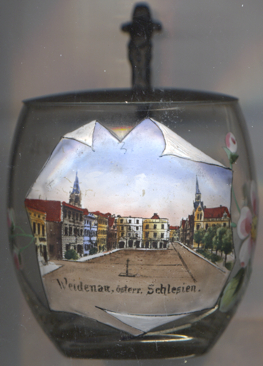

|
| ČESKÁ REPUBLIKA | CZECH REPUBLIC |
| Olomoucký kraj | Olomouc region |
| Okres: Jeseník |

 Vidnava is situated at an elevation of 233 m in the northeastern slopes of the Hrubý Jeseník
(Altvater, Gesenke) mountain region, about 16 km north of the district town Jeseník
and about 87 km north of the regional capital Olomouc. The municipality has a population of
about 1,300 (2019).
Vidnava is situated at an elevation of 233 m in the northeastern slopes of the Hrubý Jeseník
(Altvater, Gesenke) mountain region, about 16 km north of the district town Jeseník
and about 87 km north of the regional capital Olomouc. The municipality has a population of
about 1,300 (2019).
 Weidenau was probably founded in 1264 and since 1290 was part of the duchy of Nysa, an
ecclesiastical duchy ruled by the bishop of Wrocław. The earliest written mention dates
from 1291. In 1428 it obtained the privileges of a town. Following the Silesian Wars (1741–1745) the territory was
divided between Austria and Silesia, and as a consequence the neighbouring settlement of Schubertskrosse (Krasov) became
Prussian, while Weidenau remained in Austria. After World War II, the German-speaking population was mostly expelled.
In 1948, the domains that still belonged to the archduchy of Wrocław and which until then were administered from
the nearby Javorník were confiscated by the Czechoslovak state. At the same time, the name
of the town was officially changed to Vidnava. As part of border adjustments with Poland, Krasov was handed over
to Czechoslovakia in 1959 and later was incorporated into Vidnava.
Weidenau was probably founded in 1264 and since 1290 was part of the duchy of Nysa, an
ecclesiastical duchy ruled by the bishop of Wrocław. The earliest written mention dates
from 1291. In 1428 it obtained the privileges of a town. Following the Silesian Wars (1741–1745) the territory was
divided between Austria and Silesia, and as a consequence the neighbouring settlement of Schubertskrosse (Krasov) became
Prussian, while Weidenau remained in Austria. After World War II, the German-speaking population was mostly expelled.
In 1948, the domains that still belonged to the archduchy of Wrocław and which until then were administered from
the nearby Javorník were confiscated by the Czechoslovak state. At the same time, the name
of the town was officially changed to Vidnava. As part of border adjustments with Poland, Krasov was handed over
to Czechoslovakia in 1959 and later was incorporated into Vidnava.
The Roman-Catholic  parish church of St. Catherine [background left]
dates from the second half of the 13th century. During a Hussite attack it was burned down in 1482; a gothic portal
in the western vestibule has been preserved from the original building. The chapel of St. Hedwig was added at the turn
of the 16th and 17th centuries. The church burned down again in 1713 and it took until 1748 to rebuild it again. The
present external appearance of the church dates from 1883; the tower was added also at that time.
parish church of St. Catherine [background left]
dates from the second half of the 13th century. During a Hussite attack it was burned down in 1482; a gothic portal
in the western vestibule has been preserved from the original building. The chapel of St. Hedwig was added at the turn
of the 16th and 17th centuries. The church burned down again in 1713 and it took until 1748 to rebuild it again. The
present external appearance of the church dates from 1883; the tower was added also at that time.
The Neo-Gothic  town hall [right] in the central market square was built in
1867.
town hall [right] in the central market square was built in
1867.
[https://de.wikipedia.org/wiki/Vidnava, https://cs.wikipedia.org/wiki/Vidnava;
https://en.wikipedia.org/wiki/Duchy_of_Nysa]
![[scale]](lineal.jpg)